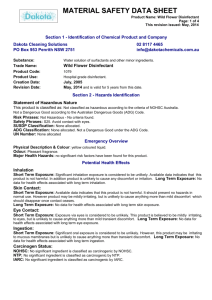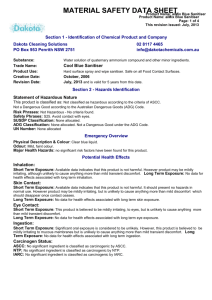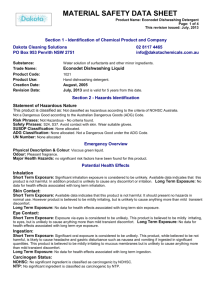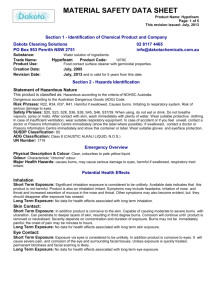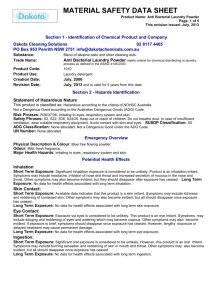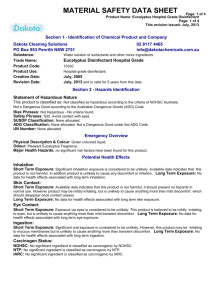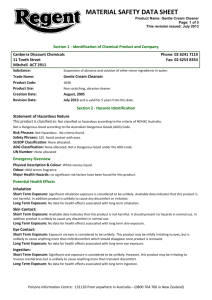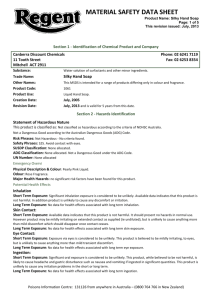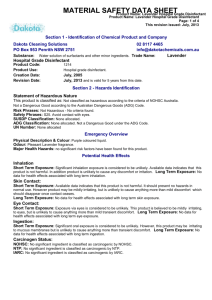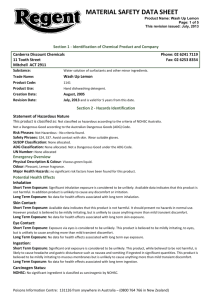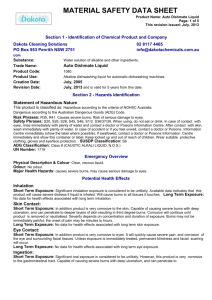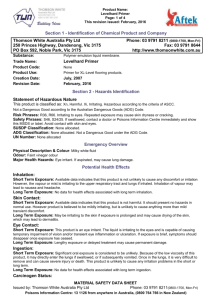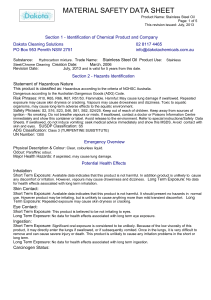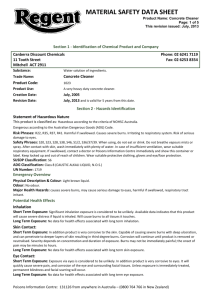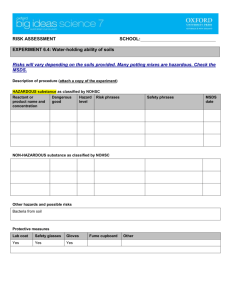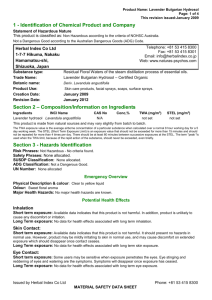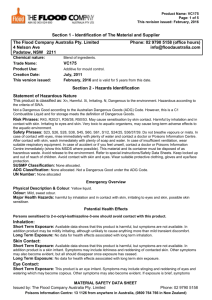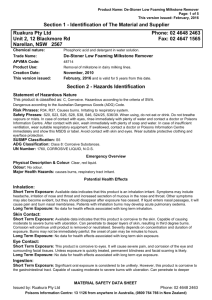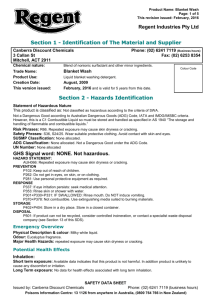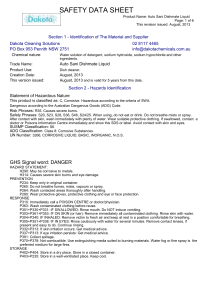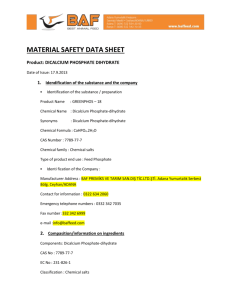MSDS Cleaning-Vinegar - Dakota Cleaning Solutions
advertisement
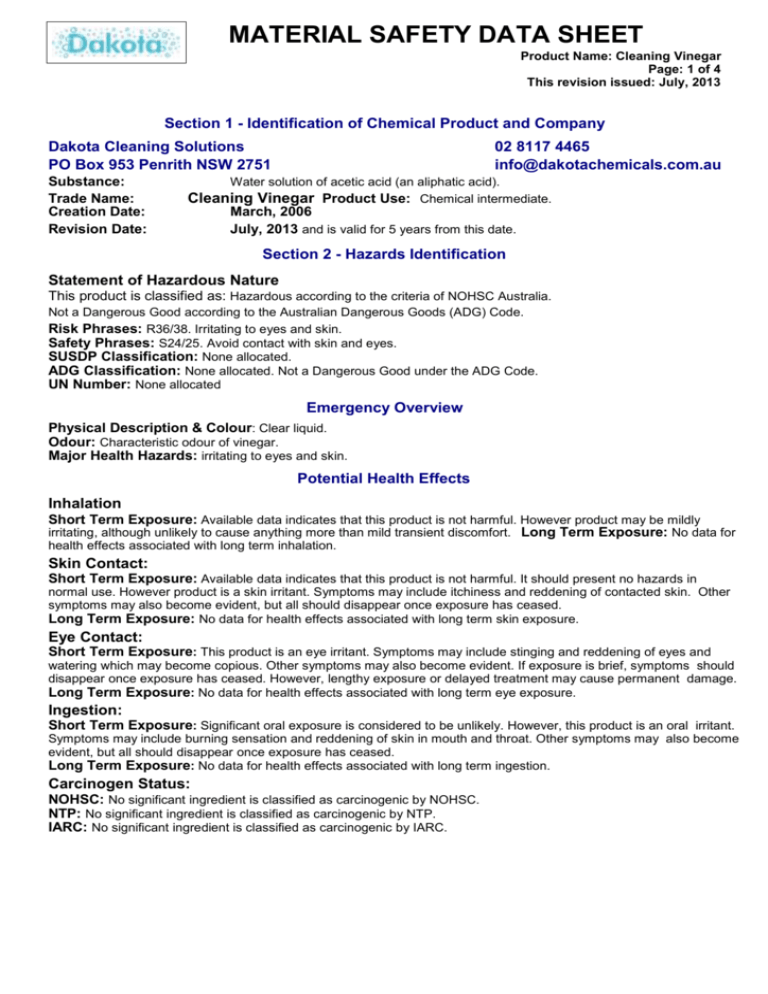
MATERIAL SAFETY DATA SHEET Product Name: Cleaning Vinegar Page: 1 of 4 This revision issued: July, 2013 Section 1 - Identification of Chemical Product and Company Dakota Cleaning Solutions PO Box 953 Penrith NSW 2751 Substance: Trade Name: Creation Date: Revision Date: 02 8117 4465 info@dakotachemicals.com.au Water solution of acetic acid (an aliphatic acid). Cleaning Vinegar Product Use: Chemical intermediate. March, 2006 July, 2013 and is valid for 5 years from this date. Section 2 - Hazards Identification Statement of Hazardous Nature This product is classified as: Hazardous according to the criteria of NOHSC Australia. Not a Dangerous Good according to the Australian Dangerous Goods (ADG) Code. Risk Phrases: R36/38. Irritating to eyes and skin. Safety Phrases: S24/25. Avoid contact with skin and eyes. SUSDP Classification: None allocated. ADG Classification: None allocated. Not a Dangerous Good under the ADG Code. UN Number: None allocated Emergency Overview Physical Description & Colour: Clear liquid. Odour: Characteristic odour of vinegar. Major Health Hazards: irritating to eyes and skin. Potential Health Effects Inhalation Short Term Exposure: Available data indicates that this product is not harmful. However product may be mildly irritating, although unlikely to cause anything more than mild transient discomfort. Long Term Exposure: No data for health effects associated with long term inhalation. Skin Contact: Short Term Exposure: Available data indicates that this product is not harmful. It should present no hazards in normal use. However product is a skin irritant. Symptoms may include itchiness and reddening of contacted skin. Other symptoms may also become evident, but all should disappear once exposure has ceased. Long Term Exposure: No data for health effects associated with long term skin exposure. Eye Contact: Short Term Exposure: This product is an eye irritant. Symptoms may include stinging and reddening of eyes and watering which may become copious. Other symptoms may also become evident. If exposure is brief, symptoms should disappear once exposure has ceased. However, lengthy exposure or delayed treatment may cause permanent damage. Long Term Exposure: No data for health effects associated with long term eye exposure. Ingestion: Short Term Exposure: Significant oral exposure is considered to be unlikely. However, this product is an oral irritant. Symptoms may include burning sensation and reddening of skin in mouth and throat. Other symptoms may also become evident, but all should disappear once exposure has ceased. Long Term Exposure: No data for health effects associated with long term ingestion. Carcinogen Status: NOHSC: No significant ingredient is classified as carcinogenic by NOHSC. NTP: No significant ingredient is classified as carcinogenic by NTP. IARC: No significant ingredient is classified as carcinogenic by IARC. Product Name: Cleaning Vinegar Page: 2 of 4 This revision issued: July, 2013 Section 3 - Composition/Information on Ingredients Ingredients CAS No Conc,% TWA (mg/m3) STEL (mg/m3) Acetic acid 64-19-7 10 25 37 Water 7732-18-5 to 100 not set not set This is a commercial product whose exact ratio of components may vary slightly. Minor quantities of other non hazardous ingredients are also possible. The TWA exposure value is the average airborne concentration of a particular substance when calculated over a normal 8 hour working day for a 5 day working week. The STEL (Short Term Exposure Limit) is an exposure value that may be equalled (but should not be exceeded) for no longer than 15 minutes and should not be repeated more than 4 times per day. There should be at least 60 minutes between successive exposures at the STEL. The term "peak "is used when the TWA limit, because of the rapid action of the substance, should never be exceeded, even briefly. Section 4 - First Aid Measures General Information: You should call The Poisons Information Centre if you feel that you may have been poisoned, burned or irritated by this product. The number is 13 1126 from anywhere in Australia (0800 764 766 in New Zealand) and is available at all times. Have this MSDS with you when you call. Inhalation: No first aid measures normally required. However, if inhalation has occurred, and irritation has developed, remove to fresh air and observe until recovered. If irritation becomes painful or persists more than about 30 minutes, seek medical advice. Skin Contact: Wash gently and thoroughly with warm water (use non-abrasive soap if necessary) until product is removed. Under running water, remove contaminated clothing, shoes and leather goods (e.g. watchbands and belts) and completely decontaminate them before reuse or discard. If irritation persists, repeat flushing and seek medical attention. Eye Contact: Immediately flush the contaminated eye(s) with lukewarm, gently flowing water for 5 minutes or until the product is removed, while holding the eyelid(s) open. Take care not to rinse contaminated water into the unaffected eye or onto the face. Obtain medical attention immediately. Take special care if exposed person is wearing contact lenses. Ingestion: If swallowed, do NOT induce vomiting. Wash mouth with water and contact a Poisons Information Centre, or call a doctor. Section 5 - Fire Fighting Measures Fire and Explosion Hazards: There is no risk of an explosion from this product under normal circumstances if it is involved in a fire. Only small quantities of decomposition products are expected from this products at temperatures normally achieved in a fire. This will only occur after heating to dryness. Fire decomposition products from this product are likely to be irritating if inhaled. Extinguishing Media: Not Combustible. Use extinguishing media suited to burning materials. Fire Fighting: If a significant quantity of this product is involved in a fire, call the fire brigade. Flash point: Does not burn. Upper Flammability Limit: Does not burn. Lower Flammability Limit: Does not burn. Autoignition temperature: Not applicable - does not burn. Flammability Class: Does not burn. Section 6 - Accidental Release Measures Accidental release: In the event of a major spill, prevent spillage from entering drains or water courses. Wear full protective clothing including eye/face protection. All skin areas should be covered. See below under Personal Protection regarding Australian Standards relating to personal protective equipment. Suitable materials for protective clothing include rubber, PVC. Eye/face protective equipment should comprise as a minimum, protective glasses and, preferably, goggles. If there is a significant chance that vapours or mists are likely to build up in the cleanup area, we recommend that you use a respirator. Usually, no respirator is necessary when using this product. However, if you have any doubts consult the Australian Standard mentioned below (section 8). Otherwise, not normally necessary. Stop leak if safe to do so, and contain spill. Absorb onto sand, vermiculite or other suitable absorbent material. If spill is too large or if absorbent material is not available, try to create a dike to stop material spreading or going into drains or waterways. Sweep up and shovel or collect recoverable product into labelled containers for recycling or salvage, and dispose of promptly. Recycle containers wherever possible after careful cleaning. After spills, wash area preventing runoff from entering drains. If a significant quantity of material enters drains, advise emergency services. Contaminated area may be neutralised by washing with weak or dilute alkali. Baking soda, washing soda and MATERIAL SAFETY DATA SHEET Issued by: Dakota Phone: 02 8117 4465 Poisons Information Centre: 13 1126 from anywhere in Australia, (0800 764 766 in New Zealand) Product Name: Cleaning Vinegar Page: 3 of 4 This revision issued: July, 2013 limestone are suitable. This material may be suitable for approved landfill. Ensure legality of disposal by consulting regulations prior to disposal. Thoroughly launder protective clothing before storage or re-use. Advise laundry of nature of contamination when sending contaminated clothing to laundry. Section 7 - Handling and Storage Handling: Keep exposure to this product to a minimum, and minimise the quantities kept in work areas. Check Section 8 of this MSDS for details of personal protective measures, and make sure that those measures are followed. The measures detailed below under "Storage" should be followed during handling in order to minimise risks to persons using the product in the workplace. Also, avoid contact or contamination of product with incompatible materials listed in Section 10. Storage: Make sure that the product does not come into contact with substances listed under "Incompatibilities" in Section 10. Check packaging - there may be further storage instructions on the label. Section 8 - Exposure Controls and Personal Protection The following Australian Standards will provide general advice regarding safety clothing and equipment: Respiratory equipment: AS/NZS 1715, Protective Gloves: AS 2161, Industrial Clothing: AS2919, Industrial Eye Protection: AS1336 and AS/NZS 1337, Occupational Protective Footwear: AS/NZS2210. Exposure Limits TWA (mg/m3) STEL (mg/m3) Acetic acid 25 37 No special equipment is usually needed when occasionally handling small quantities. The following instructions are for bulk handling or where regular exposure in an occupational setting occurs without proper containment systems. Ventilation: This product should only be used where there is ventilation that is adequate to keep exposure below the TWA levels. If necessary, use a fan. Eye Protection: Protective glasses or goggles should be worn when this product is being used. Failure to protect your eyes may cause them harm. Emergency eye wash facilities are also recommended in an area close to where this product is being used. Skin Protection: Prevent skin contact by wearing impervious gloves, clothes and, preferably, apron. Make sure that all skin areas are covered. See below for suitable material types. Protective Material Types: We suggest that protective clothing be made from the following: rubber, PVC. Respirator: Usually, no respirator is necessary when using this product. However, if you have any doubts consult the Australian Standard mentioned above. Otherwise, not normally necessary. Eyebaths or eyewash stations and safety deluge showers should be provided near to where product is being used. Section 9 - Physical and Chemical Properties: Physical Description & colour: Clear liquid. Odour: Characteristic odour of vinegar. Boiling Point: Approximately 100°C at 100kPa. Freezing/Melting Point: Approximately 0°C. Volatiles: Water component. Vapour Pressure: 2.37 kPa at 20°C (water vapour pressure). Vapour Density: No data. Specific Gravity: 1.046 Water Solubility: Completely soluble in water. pH: Approx 2.0 Volatility: Odour Threshold: No data. Evaporation Rate: No data. Coeff Oil/water Distribution: No data Autoignition temp: Not applicable - does not burn. No data. Section 10 - Stability and Reactivity Reactivity: This product is unlikely to react or decompose under normal storage conditions. However, if you have any doubts, contact the supplier for advice on shelf life properties. Conditions to Avoid: None known. Incompatibilities: bases, amines, zinc, tin, aluminium and their alloys. Fire Decomposition: Only small quantities of decomposition products are expected from this products at temperatures normally achieved in a fire. This will only occur after heating to dryness. Carbon dioxide, and if combustion is incomplete, carbon monoxide and smoke. Water. Carbon monoxide poisoning produces headache, MATERIAL SAFETY DATA SHEET Issued by: Dakota Phone: 02 8117 4465 Poisons Information Centre: 13 1126 from anywhere in Australia, (0800 764 766 in New Zealand) Product Name: Cleaning Vinegar Page: 4 of 4 This revision issued: July, 2013 weakness, nausea, dizziness, confusion, dimness of vision, disturbance of judgment, and unconsciousness followed by coma and death. Polymerisation: This product will not undergo polymerisation reactions. Section 11 - Toxicological Information Local Effects: Target Organs: eyes Classification of Hazardous Ingredients Ingredient Risk Phrases Acetic Acid >=10%Conc<25%: Xi; R36/38 Section 12 - Ecological Information This product is biodegradable. It will not accumulate in the soil or water or cause long term problems. Section 13 - Disposal Considerations Disposal: There are many pieces of legislation covering waste disposal and they differ in each state and territory, so each user must refer to laws operating in their area. In some areas, certain wastes must be tracked. The Hierarchy of Controls seems to be common - the user should investigate: Reduce, Reuse, and Recycle and only if all else fails should disposal be considered. Note that properties of a product may change in use, so that the following suggestions may not always be appropriate. The following may help you in properly addressing this matter for this product. This product may be recycled if unused, or if it has not been contaminated so as to make it unsuitable for its intended use. If it has been contaminated, it may be possible to separate the contamination in some way. Only if neither of these options is suitable, consider landfill. Section 14 - Transport Information ADG Code: This product is not classified as a Dangerous Good. No special transport conditions are necessary unless required by other regulations. Section 15 - Regulatory Information AICS: All of the significant ingredients in this formulation are compliant with NICNAS regulations. The following ingredients: Acetic acid, are mentioned in the SUSDP. Section 16 - Other Information This MSDS contains only safety-related information. For other data see product literature. Acronyms: ADG Code AICS CAS Number IARC NOHSC NTP R-Phrase SUSDP UN Number Australian Code for the Transport of Dangerous Goods by Road and Rail Australian Inventory of Chemical Substances Chemical Abstracts Service Registry Number International Agency for Research on Cancer National Occupational Health and Safety Commission National Toxicology Program (USA) Risk Phrase Standard for the Uniform Scheduling of Drugs & Poisons United Nations Number THIS MSDS SUMMARISES OUR BEST KNOWLEDGE OF THE HEALTH AND SAFETY HAZARD INFORMATION OF THE PRODUCT AND HOW TO SAFELY HANDLE AND USE THE PRODUCT IN THE WORKPLACE. EACH USER MUST REVIEW THIS MSDS IN THE CONTEXT OF HOW THE PRODUCT WILL BE HANDLED AND USED IN THE WORKPLACE. IF CLARIFICATION OR FURTHER INFORMATION IS NEEDED TO ENSURE THAT AN APPROPRIATE RISK ASSESSMENT CAN BE MADE, THE USER SHOULD CONTACT THIS COMPANY SO WE CAN ATTEMPT TO OBTAIN ADDITIONAL INFORMATION FROM OUR SUPPLIERS OUR RESPONSIBILITY FOR PRODUCTS SOLD IS SUBJECT TO OUR STANDARD TERMS AND CONDITIONS, A COPY OF WHICH IS SENT TO OUR CUSTOMERS AND IS ALSO AVAILABLE ON REQUEST. Please read all labels carefully before using product. This MSDS is prepared in accord with the NOHSC document “National Code of Practice for the Preparation of Material Safety Data Sheets” 2nd Edition [NOHSC:2011(2003)] Copyright © Kilford & Kilford Pty Ltd, June, 2011. http://www.kilford.com.au/ Phone (02)9251 4532 MATERIAL SAFETY DATA SHEET Issued by: Dakota Phone: 02 8117 4465 Poisons Information Centre: 13 1126 from anywhere in Australia, (0800 764 766 in New Zealand)
